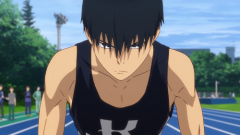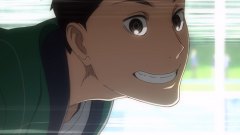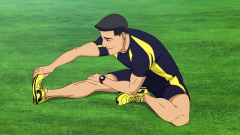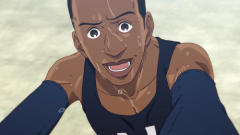Recently, sports anime have become a bit of a dying breed. Falling into the same hole as Mecha, aside from a passionate base audience, most are overlooked. There are the occasional hits like Haikyuu, Yuri on Ice, or Darling in the Franxx for Mecha, but those are few and far between, often taking years. Even then, rarely does a series come along that can reach the heights of the old classics such as Hajime no Ippo or One Outs. However, Kaze ga Tsuyoku Fuiteiru, Kaze Fui or Run With the Wind, attempts to do just that. With a phenomenal cast, tight direction and a 5 episode finale that was executed neigh perfectly, Kaze Fui is one of my favorite sports anime in recent years.
So that said, lets jump in!
[slideshow_deploy id=’30802′]
Animation/Art
We have to, as always, start off with the art and animation. This is perhaps Kaze Fui’s rockiest area, which considering the ending is saying something. Right off the bat, I need to start with the harshest criticism, the CGI. In multiple scenes at the start/middle of the series, CGI runners are rampant. They stand out, their run cycles are all basically the same, just offset, and they are ugly to look at. Simply put, the CGI is something that has to go in the BD release. Luckily, this gets less prevalent as the series goes on and we barrel down to the Hakone Ekiden, the big event. Had the finale been as laden with CGI runners as most of the other races, I do not think it would have been near as successful. However, with my only major gripe out of the way, what does it do right?
The answer is, a lot. Kaze Fui does a lot right. First off, when the animation is on, it is on. Multiple times in the finale I just thought “Wow, this is beautiful”. Its a combination of the direction and animation, sure, but it looks fantastic. Art wise the series also stands out. Production IG’s style here just resonates with me, as it is a similar style to their recent Welcome to the Ballroom. Tall, lean bodies with long legs and striking eyes. Bright colors to make every scene pop, and particular detail put into the characters musculature. When zoomed out for group shots, a good deal of this detail is lost. But when Kaze Fui focuses in on a single character, their experiences and their story, you can’t look away. So while the CGI is painful, it is surrounded by enough beauty to, if not forgive, to forget it.
[slideshow_deploy id=’30805′]
Direction
Next up we have the direction, the cinematography, the art of the scene itself. At its worst, I would classify Kaze Fui as average. At a minimum, every shot serves as a place for the characters to interact. Never detracting from what is going on. Meanwhile at its best, the composition enhances the emotions on screen. The best examples of this take place, naturally, in the finale. Where each individual character has the spotlight and their stories are given time to shine. However there are plenty of examples of this prior to the finale. One stand out for me is during their training arc at the lake, with beautiful mountain vista’s. Often the shot places our cast in the corner, or zoomed out, making a point of just how small they are in the grand world.
Kaze Fui also makes great use of perspective and its “camera” during a number of its running scenes. Tilting with Yuki as he makes his turns, or tracking Kurahara as he sprints by from another characters perspective. The sense of speed pretty much anytime Kurahara runs is especially worth mentioning. As his talent is made clear without any need for words, making his performance never feel unearned or out of nowhere. Suffice to say, Kaze Fui’s direction does more of the heavy lifting than the animation does. Making scenes with minimal movement feel much more impactful. From just sitting in a bath at night to lounging in a field, the intent of the scenes are clear, and so I can’t help but call this category a success as well.
[slideshow_deploy id=’30807′]
Story/World
Now though we can start getting to the meat of the series, the story and characters. Considering how intertwined the two are in this case, talking about one without the other is neigh impossible. So this section will be on the characters stories and journey, where as that section will be on their depth and personality. For those stories, once again, Kaze Fui did fantastically. The only complaint I can really make here is that some concepts/plot threads were shoved under the bed for conveniences sake. While most of the work was left for the finale to cleanup in one big chunk. Those chunks were fantastic and emotionally resonate. I teared up at least once an episode during the finale. However this does occasionally make them feel underdeveloped until the literal last seconds of their arc. The quality of those arcs more than makes up for it though.
While the individual characters stories, excluding Kurahara, might feel sparse at times though the overall arc does not. Their transformation from ragtag band of dorm mates to full fledged team is beautiful. Step by step we see them coming together, taking roles and putting their individual skills to use. Kaze Fui does a fantastic job of having each individual grow, but most of all, our lead Kurahara Kakeru is nothing short of astounding. His growth from angry and closed off to happy, relaxed and emotional was fantastically done. Considering a good 80% of the show is dedicated to this arc, that is a very good thing. This boy provides emotional payoff after emotional payoff, each step of the way growing as a person. Suffice to say, when focusing on Kurahara, Kaze Fui’s story is strong.
[slideshow_deploy id=’30810′]
Characters
As far as the characters go, this is Kaze Fui’s strongest point. Each member of our core 10 is well fleshed out and established. While their individual story arcs are done with varying degrees of success, all of them are easily distinguished from each other. Every single member of this core group, from Yuki and Musa to Prince and King, are distinct in their personalities and histories. Its astounding really, as there are shows with a cast half this size that can’t manage that beyond stereotypes. Yet not a single member of Kaze Fui is easily classified as one, not by the end. Piece by piece Kaze Fui pulls back their layers. The tact and skill with which Kaze Fui does this makes each one relatable. And that might be it’s greatest strength. Somehow making 10 different people, with different dreams and circumstances, relatable in each their own way.
The biggest complaint I have seen, that I agree with about the characters, is their running ability. For lue of a better place to put this in the review, their progress simply isn’t realistic. For example, in the span of a year Prince goes from having never run a day in his life, to finishing a section of Japan’s largest college race. Sure, it’s a close thing. But as much as I love the kid, he had no business being in that race in the first place. Personally, I found this to be a minor gripe that stopped bothering me by the end. Kaze Fui had drawn me in to its narrative and it no longer mattered. If you can put aside the scientific quandaries of the original Steins;Gate time travel, or Hajime no Ippo’s bullet punches, then Kaze Fui’s stretching the effects of training shouldn’t bother you much.
[slideshow_deploy id=’30812′]
Music
Finally, lets talk music. Kaze Fui’s OST is an interesting one, it’s very quiet and subtle. Its purpose being to enhance a scene, rather than dominate it. With only a few standout tracks, ones that stick in your memory, it just doesn’t fit the same mold as the recent Megalo Box or Devilman. It is an OST meant to be listened to with the accompanying visuals, not imbuing a scene with emotion inherently but focusing on enhancing what is already there. Personally I quite enjoy it, its the sort of tracks I could listen to while running and just zone out for 30 minutes. Never once hearing a spoken word or getting pulled out by heavy choruses. Basically, If I were to rate this OST as a standalone, it would be just a little above average most likely. Nothing to write home about. But in context, it fits perfectly.
Conclusion
So all in all, how was Kaze ga Tsuyoku Fuiteiru? Phenomenal. One of my favorite series from last year and easily one of the best sports series I have had the pleasure to watch. I expected very little from it going in. After all, its a series about running, how exciting can that be? Yet still it managed to surprise me. Kaze Fui was never going to be some kind of mega blockbuster. It doesn’t have the bombastic nature of big Shounen like Mob Psycho, nor the brand recognition of Attack on Titan or One Punch Man. It’s a drama about sports, a genre most nerds tend to avoid because of preconceptions about sports. It was doomed to a niche audience from the start. But I firmly believe that, among that audience, it will and has become a classic. The sort you revisit time and time again.
What I am saying it, if you are reading this and have not watched Kaze Fui, if you have even the slightest interest in sports, watch this. You will not regret it. I know I don’t.







I love reading your reviews. You explain the things I found beautiful that i could not put into words. Its wonderful.
In the case of Prince. There’s a high possibility if we relate that to reality is agreeable. For one is, what other skills you really need in running? None. You basically only need to run and gradually just add more practice time for build up run.
If you compare that to other sports like volleyball, that requires mastery of different skills and mastery of oneself. A year is not possible. In swimming, you need to master different forms and find what style suites you.
However, running has only has one skill and one form. This makes your focus easier because you only need to think running. That’s why a year is possible to run in hakone, but dont believe your team will dominate it. 😉 you still need alot of years for that.
Thank you! I appreciate you reading! I do it for those few who comment.
For running, I think boiling it down like that is a bit disingenuous myself. Skill wise, sure, it is less complicated I would assume. But its not the skill from Prince I am worried about, but rather the endurance. Athletic ability, discounting skill and everything else, takes time. Shaving 30 seconds off your run, takes time. Its a lot of work. I myself don’t run at the level of our beautiful boys in this series, but I do run when working out for Boxing. It took me a few months to be able to run an 8 minute mile, but shaving it lower than that took exponentially longer. Its a hard workout.
So I dont deny the skill aspect of Prince’s growth. Just the physical abilities of it. Prince’s section was 21km or about 13 miles. Just finishing that is difficult, but to do it in an roughly an hour? Say hour and a half if we are being generous? Thats 13 consecutive 7 minute miles. That is tough.
Still, it was a fantastic series, and I refuse to let a nitpick ruin it for me. I love Prince, and it was a beautiful moment to see him finish the race.
I have to say, despite being excited for this series since it started airing(just waited until it finished so I could marathon it) and reading all the praise on here as it was airing, I still ended up underestimating just how emotional those last 5 episodes were.
It really is one of if not the best finale in recent memory for me.